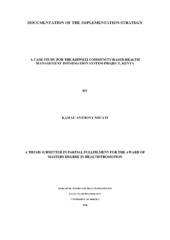| dc.contributor.author | Kamau, Anthony Nduati | |
| dc.date.accessioned | 2010-10-12T14:40:51Z | |
| dc.date.available | 2010-10-12T14:40:51Z | |
| dc.date.issued | 2010-05-19 | eng |
| dc.date.submitted | 2010-05-19 | eng |
| dc.identifier.uri | https://hdl.handle.net/1956/4276 | |
| dc.description.abstract | Purpose and Objectives: The purpose of this study was to document the comprehensive implementation strategy of the AMREF Kibwezi Community Based Health Management Information System project (CB-HMIS). The study also attempted to establish the challenges encountered during the implementation of the project. This was also an opportunity to test the appropriateness of the Bergen model of collaborating functioning in project evaluation. The Bergen model of collaborative functioning has three main elements i.e. (a) Inputs (b) Throughputs or Processes (c) Outputs. The CB-HMIS project was implemented through the collaboration of several partners i.e. AMREF the lead implementing agency, the Kenya government as well as other stakeholders. The cooperation of the government played a significant role in the implementation. The study sought to ascertain how the various partners collaborated and how the inputs interacted with one another to produce the intended outputs. Methods: A case study qualitative research design was adopted. Data collection methods involved-: (i) A review of the project documents (ii) In-depth interviews with the AMREF Kibwezi CB-HMIS project staff as well as selected stakeholders (iii) Focus group discussions with representatives of the initial village health committees and (iv) Review of the project‟s income generating projects. Results: The findings revealed that the partners collaborated well culminating in the successful implementation of the pilot project. Subsequently the project is now being scaled-up in three other districts. The training of community representatives i.e. TOTs/CHWs who acted as change agents played a very important role in the process of the project implementation and maintenance. In an effort to ensure sustainability of the project, income generating projects were initiated and they played a significant role in improving the socio-economic welfare of the community. Some constraints were encountered during the implementation but they were resolved and the process went on as planned. Conclusion: The study established that with effective leadership and good collaboration between different partners sustainable community development can be achieved. However there is one key prerequisite for this to materialize. The community has to be actively involved in the activities of the project especially in most of the decisions concerning the project. This helps in realizing ownership of the project by the community. | en_US |
| dc.format.extent | 2061927 bytes | eng |
| dc.format.mimetype | application/pdf | eng |
| dc.language.iso | eng | eng |
| dc.publisher | The University of Bergen | eng |
| dc.title | Documentation of the Implementation strategy. A case study for the Kibwezi Community-Based Health Management Information System project, Kenya | eng |
| dc.type | Master thesis | |
| dc.rights.holder | Copyright the author. All rights reserved | |
| dc.rights.holder | The author | eng |
| dc.description.degree | Master of Philosophy in Health Promotion | |
| dc.description.localcode | PSHE390T | |
| dc.description.localcode | MPHEPRO | |
| dc.subject.nus | 769909 | eng |
| dc.subject.nsi | VDP::Medisinske Fag: 700::Helsefag: 800 | nob |
| fs.subjectcode | PSHE390T | |
